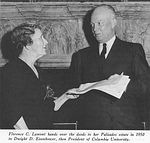Two exciting Lamont projects
The Lamont Hall Project
Lamont Hall, the majestic 1929 vintage mansion, has been the intellectual, cultural, and emotional center of the Lamont-Doherty Earth Observatory campus for nearly 70 years. Its corridors hold the echoes of Observatory founder Maurice Ewing and a legion of groundbreaking Earth scientists. It was originally built as country home for financier Thomas Lamont. The building is richly appointed with brownstone, clapboard, and slate roof on the exterior, lath and plaster interior with intricate crown molding, millwork finishes and hardwood floors.
After Thomas Lamont’s death in 1948, his widow Florence donated the house—then known as “Torrey Cliff”— to Columbia University for its geological observatory. From the beginning, LDEO has put the beautiful dwelling to work, using the space to house early seismometers, offices, and even the nascent sediment core collection. Now, as Lamont-Doherty approaches its 70th anniversary, the Observatory has envisioned a bold future purpose for the house and is now developing support to fund a full-scale renovation and restoration project. “It is an ambitious plan. Lamont Hall will become a technology equipped administrative and conference center, and serve as an event space in which to bring the local community into the life of the Observatory,” said LDEO Director Sean Solomon.
Among the new amenities under consideration are space for conferencing, education, and public outreach. The new structure will include a visitors' center to welcome guests for campus tours and special conferences. When completed, Lamont Hall will stand as an even prouder tribute to the Lamont family and play an integral part in Lamont’s ongoing tradition of dynamic collaboration and world leadership in breakthrough research.
THE PIERMONT PIER PROJECTt:
The Hudson River Field Station: Taking Science to the Piermont Pier
Near the end of the Piermont Pier is a small, unassuming structure. The building, informally known as the pier block house, has actually been an active site for Lamont-Doherty Earth Observatory research. Once a place to house instruments dedicated to monitoring local river chemistry and quality, the building was heavily damaged during Superstorm Sandy and the lab was completely destroyed.
Now, Lamont perceives an enormous opportunity in this small structure and is developing support for a full-scale renovation to create a new field station to serve the multiple goals of research, outreach, and education. Lamont envisions this restored building as a wonderful and valued link between Lamont and the surrounding communities — a resource that will help explain what Lamont is and does so its Piermont neighbors can embrace the world-class global research happening every day in their community. It will also simultaneously educate the public and school children about the natural history of their local environment.
The project is called Columbia University’s Lamont-Doherty Earth Observatory Hudson River Field Station. Once completed, the Observatory envisions an exciting attraction. Inside, the station will contain space dedicated to research and technology, which will be housed behind a glass wall. This will be a working lab.
The remainder of the building will be designed as a museum or Exploratorium with vivid displays that will be open to the public. Among the features proposed, a seismograph, constantly recording incoming data; a microscope exhibit where people can look at microfossils, fish larvae, pollen, etc.; and a large projected video on screen showing Lamont’s scientists in action at all of the other LDEO “field stations” around the world.




